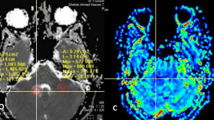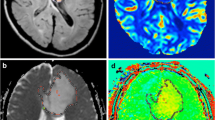Abstract
Amide proton transfer (APT) magnetic resonance imaging is gaining attention for its capability for grading glial tumors. Usually, a representative slice is analyzed. Different definitions of tumor areas have been employed in previous studies. We hypothesized that the accuracy of APT imaging for brain tumor grading may depend upon the analytical methodology used, such as selection of regions of interest (ROIs), single or multiple tumor slices, and whether or not there is normalization to the contralateral white matter. This study was approved by the institutional review board, and written informed consent was waived. Twenty-six patients with histologically proven glial tumors underwent preoperative APT imaging with a three-dimensional gradient-echo sequence. Two neuroradiologists independently analyzed APT asymmetry (APTasym) images by placing ROIs on both a single representative slice (RS) and all slices including tumor (i.e. whole tumor: WT). ROIs indicating tumor extent were separately defined on both FLAIR and, if applicable, contrast-enhanced T1-weighted images (CE-T1WI), yielding four mean APTasym values (RS-FLAIR, WT-FLAIR, RS-CE-T1WI, and WT-CE-T1WI). The maximum values were also measured using small ROIs, and their differences among grades were evaluated. Receiver operating characteristic (ROC) curve analysis was also conducted on mean and maximum values. Intra-class correlation coefficients for inter-observer agreement were excellent. Significant differences were observed between high- and low-grade gliomas for all five methods (P < 0.01). ROC curve analysis found no statistically significant difference among them. This study clarifies that single-slice APT analysis is robust despite tumor heterogeneity, and can grade glial tumors with or without the use of contrast material.




Similar content being viewed by others
References
Ward KM, Balaban RS (2000) Determination of pH using water protons and chemical exchange dependent saturation transfer (CEST). Magn Reson Med 44:799–802
Ward KM, Aletras AH, Balaban RS (2000) A new class of contrast agents for MRI based on proton chemical exchange dependent saturation transfer (CEST). J Magn Reson 143:79–87. doi:10.1006/jmre.1999.1956
Sherry AD, Woods M (2008) Chemical exchange saturation transfer contrast agents for magnetic resonance imaging. Annu Rev Biomed Eng 10:391–411. doi:10.1146/annurev.bioeng.9.060906.151929
van Zijl PC, Yadav NN (2011) Chemical exchange saturation transfer (CEST): what is in a name and what isn’t? Magn Reson Med 65:927–948. doi:10.1002/mrm.22761
Zhou J, Payen JF, Wilson DA, Traystman RJ, van Zijl PC (2003) Using the amide proton signals of intracellular proteins and peptides to detect pH effects in MRI. Nat Med 9:1085–1090. doi:10.1038/nm907
Zhou J, Lal B, Wilson DA, Laterra J, van Zijl PC (2003) Amide proton transfer (APT) contrast for imaging of brain tumors. Magn Reson Med 50:1120–1126. doi:10.1002/mrm.10651
Zhou J, Yan K, Zhu H (2012) A simple model for understanding the origin of the amide proton transfer MRI signal in tissue. Appl Magn Reson 42:393–402. doi:10.1007/s00723-011-0306-5
Sun PZ, Benner T, Copen WA, Sorensen AG (2010) Early experience of translating pH-weighted MRI to image human subjects at 3 Tesla. Stroke 41:S147–S151. doi:10.1161/STROKEAHA.110.595777
Gerigk L, Schmitt B, Stieltjes B, Roder F, Essig M, Bock M, Schlemmer HP, Rothke M (2012) 7 Tesla imaging of cerebral radiation necrosis after arteriovenous malformations treatment using amide proton transfer (APT) imaging. J Magn Reson Imaging 35:1207–1209. doi:10.1002/jmri.23534
Jia G, Abaza R, Williams JD, Zynger DL, Zhou J, Shah ZK, Patel M, Sammet S, Wei L, Bahnson RR, Knopp MV (2011) Amide proton transfer MR imaging of prostate cancer: a preliminary study. J Magn Reson Imaging 33:647–654. doi:10.1002/jmri.22480
Dula AN, Arlinghaus LR, Dortch RD, Dewey BE, Whisenant JG, Ayers GD, Yankeelov TE, Smith SA (2013) Amide proton transfer imaging of the breast at 3 T: establishing reproducibility and possible feasibility assessing chemotherapy response. Magn Reson Med 70:216–224. doi:10.1002/mrm.24450
Jones CK, Schlosser MJ, van Zijl PC, Pomper MG, Golay X, Zhou J (2006) Amide proton transfer imaging of human brain tumors at 3T. Magn Reson Med 56:585–592. doi:10.1002/mrm.20989
Zhou J, Blakeley JO, Hua J, Kim M, Laterra J, Pomper MG, van Zijl PC (2008) Practical data acquisition method for human brain tumor amide proton transfer (APT) imaging. Magn Reson Med 60:842–849. doi:10.1002/mrm.21712
Wen Z, Hu S, Huang F, Wang X, Guo L, Quan X, Wang S, Zhou J (2010) MR imaging of high-grade brain tumors using endogenous protein and peptide-based contrast. Neuroimage 51:616–622. doi:10.1016/j.neuroimage.2010.02.050
Zhao X, Wen Z, Zhang G, Huang F, Lu S, Wang X, Hu S, Chen M, Zhou J (2013) Three-dimensional turbo-spin-echo amide proton transfer MR imaging at 3-Tesla and its application to high-grade human brain tumors. Mol Imaging Biol 15:114–122. doi:10.1007/s11307-012-0563-1
Zhou J, Zhu H, Lim M, Blair L, Quinones-Hinojosa A, Messina SA, Eberhart CG, Pomper MG, Laterra J, Barker PB, van Zijl PC, Blakeley JO (2013) Three-dimensional amide proton transfer MR imaging of gliomas: initial experience and comparison with gadolinium enhancement. J Magn Reson Imaging. doi:10.1002/jmri.24067
Togao O, Yoshiura T, Keupp J, Hiwatashi A, Yamashita K, Kikuchi K, Suzuki Y, Suzuki SO, Iwaki T, Hata N, Mizoguchi M, Yoshimoto K, Sagiyama K, Takahashi M, Honda H (2014) Amide proton transfer imaging of adult diffuse gliomas: correlation with histopathological grades. Neuro Oncol 16:441–448. doi:10.1093/neuonc/not158
Earnest Ft, Kelly PJ, Scheithauer BW, Kall BA, Cascino TL, Ehman RL, Forbes GS, Axley PL (1988) Cerebral astrocytomas: histopathologic correlation of MR and CT contrast enhancement with stereotactic biopsy. Radiology 166:823–827. doi:10.1148/radiology.166.3.2829270
Tovi M, Hartman M, Lilja A, Ericsson A (1994) MR imaging in cerebral gliomas. Tissue component analysis in correlation with histopathology of whole-brain specimens. Acta Radiol 35:495–505
Hobbs SK, Shi G, Homer R, Harsh G, Atlas SW, Bednarski MD (2003) Magnetic resonance image-guided proteomics of human glioblastoma multiforme. J Magn Reson Imaging 18:530–536. doi:10.1002/jmri.10395
Sottoriva A, Spiteri I, Piccirillo SG, Touloumis A, Collins VP, Marioni JC, Curtis C, Watts C, Tavare S (2013) Intratumor heterogeneity in human glioblastoma reflects cancer evolutionary dynamics. Proc Natl Acad Sci USA 110:4009–4014. doi:10.1073/pnas.1219747110
Sagiyama K, Mashimo T, Togao O, Vemireddy V, Hatanpaa KJ, Maher EA, Mickey BE, Pan E, Sherry AD, Bachoo RM, Takahashi M (2014) In vivo chemical exchange saturation transfer imaging allows early detection of a therapeutic response in glioblastoma. Proc Natl Acad Sci USA. doi:10.1073/pnas.1323855111
Kleihues PLD, Wiestler OD, Burger PC, Scheithauer BW (2007) WHO grading of tumours of the central nervous system. In: Louis DN, Ohgaki H, Wiestler OD, Cavenee WK (eds) WHO classification of tumours of the central nervous system, 4th edn. IARC, Lyon, pp 10–11
Agarwal S, Sharma MC, Jha P, Pathak P, Suri V, Sarkar C, Chosdol K, Suri A, Kale SS, Mahapatra AK (2013) Comparative study of IDH1 mutations in gliomas by immunohistochemistry and DNA sequencing. Neuro Oncol 15:718–726. doi:10.1093/neuonc/not015
Schmitt B, Zaiss M, Zhou J, Bachert P (2011) Optimization of pulse train presaturation for CEST imaging in clinical scanners. Magn Reson Med 65:1620–1629. doi:10.1002/mrm.22750
Schmitt B, Zbyn S, Stelzeneder D, Jellus V, Paul D, Lauer L, Bachert P, Trattnig S (2011) Cartilage quality assessment by using glycosaminoglycan chemical exchange saturation transfer and (23)Na MR imaging at 7 T. Radiology 260:257–264. doi:10.1148/radiol.11101841
Palumbo B, Angotti F, Marano GD (2009) Relationship between PET-FDG and MRI apparent diffusion coefficients in brain tumors. Q J Nucl Med Mol Imaging 53:17–22
DeLong ER, DeLong DM, Clarke-Pearson DL (1988) Comparing the areas under two or more correlated receiver operating characteristic curves: a nonparametric approach. Biometrics 44:837–845
Cha S (2006) Update on brain tumor imaging: from anatomy to physiology. AJNR Am J Neuroradiol 27:475–487
Essig M, Anzalone N, Combs SE, Dorfler A, Lee SK, Picozzi P, Rovira A, Weller M, Law M (2012) MR imaging of neoplastic central nervous system lesions: review and recommendations for current practice. AJNR Am J Neuroradiol 33:803–817. doi:10.3174/ajnr.A2640
Sugahara T, Korogi Y, Kochi M, Ikushima I, Shigematu Y, Hirai T, Okuda T, Liang L, Ge Y, Komohara Y, Ushio Y, Takahashi M (1999) Usefulness of diffusion-weighted MRI with echo-planar technique in the evaluation of cellularity in gliomas. J Magn Reson Imaging 9:53–60
Lam WW, Poon WS, Metreweli C (2002) Diffusion MR imaging in glioma: does it have any role in the pre-operation determination of grading of glioma? Clin Radiol 57:219–225. doi:10.1053/crad.2001.0741
Zhou J, Tryggestad E, Wen Z, Lal B, Zhou T, Grossman R, Wang S, Yan K, Fu DX, Ford E, Tyler B, Blakeley J, Laterra J, van Zijl PC (2011) Differentiation between glioma and radiation necrosis using molecular magnetic resonance imaging of endogenous proteins and peptides. Nat Med 17:130–134. doi:10.1038/nm.2268
Hong X, Liu L, Wang M, Ding K, Fan Y, Ma B, Lal B, Tyler B, Mangraviti A, Wang S, Wong J, Laterra J, Zhou J (2014) Quantitative multiparametric MRI assessment of glioma response to radiotherapy in a rat model. Neuro Oncol 16:856–867. doi:10.1093/neuonc/not245
Gerlinger M, Rowan AJ, Horswell S, Larkin J, Endesfelder D, Gronroos E, Martinez P, Matthews N, Stewart A, Tarpey P, Varela I, Phillimore B, Begum S, McDonald NQ, Butler A, Jones D, Raine K, Latimer C, Santos CR, Nohadani M, Eklund AC, Spencer-Dene B, Clark G, Pickering L, Stamp G, Gore M, Szallasi Z, Downward J, Futreal PA, Swanton C (2012) Intratumor heterogeneity and branched evolution revealed by multiregion sequencing. N Engl J Med 366:883–892. doi:10.1056/NEJMoa1113205
Vargas HA, Delaney HG, Delappe EM, Wang Y, Zheng J, Moskowitz CS, Tan Y, Zhao B, Schwartz LH, Hricak H, Russo P, Akin O (2013) Multiphasic contrast-enhanced MRI: single-slice versus volumetric quantification of tumor enhancement for the assessment of renal clear-cell carcinoma fuhrman grade. J Magn Reson Imaging 37:1160–1167. doi:10.1002/jmri.23899
Paech D, Zaiss M, Meissner JE, Windschuh J, Wiestler B, Bachert P, Neumann JO, Kickingereder P, Schlemmer HP, Wick W, Nagel AM, Heiland S, Ladd ME, Bendszus M, Radbruch A (2014) Nuclear overhauser enhancement mediated chemical exchange saturation transfer imaging at 7 Tesla in glioblastoma patients. PLoS One 9:e104181. doi:10.1371/journal.pone.0104181
Acknowledgments
The authors express their sincere gratitude to Mr. Katsutoshi Murata, Siemens Japan, KK for his assistance in optimization of APT imaging in this study.
Conflict of interest
Benjamin Schmitt was an employee of Simens AG and is an emplyee of Siemens ltd. The other authors have no conflicts of interest related to this study. There is no conflict of interest nor funding to disclose related to this study.
Ethical standards
This study complies with the current laws of the country in which they were performed.
Author information
Authors and Affiliations
Corresponding author
Rights and permissions
About this article
Cite this article
Sakata, A., Okada, T., Yamamoto, A. et al. Grading glial tumors with amide proton transfer MR imaging: different analytical approaches. J Neurooncol 122, 339–348 (2015). https://doi.org/10.1007/s11060-014-1715-8
Received:
Accepted:
Published:
Issue Date:
DOI: https://doi.org/10.1007/s11060-014-1715-8




